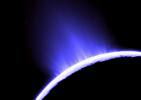 |
The 2009 JPL-Caltech Summer Titan SURF Projectjplcdsmeetings/Header |
||
|
|
|||
|
One of the critical issues for a balloon on Titan will be how the balloon gets deployed. A full-blown modeling and simulation study is not believed to be feasible at this point, and so initial studies of how current deployment techniques used for Earth-bound balloons might be modified for the cryogenic atmosphere on Titan will be the main focus. A main goal will be to compile a list of key issues that need to be addressed in further studies of deployment. As for navigation, it would be of interest to monitor how pilots currently steer in balloon competitions. They navigate autonomously with information only from a GPS in the basket yet achieve remarkable results. I think part of what they do is logical and part of it instinctive and it would be valuable to understand how they reach goals with remarkable precision – often to within a few meters.
Notes from Julian Nott: Firstly, I assume this does not include numerical modeling. The former Irvin Parachute in Santa Ana, California, now called airborne systems, made the Huygens parachute and are making the parachutes for the descent and safe return to Earth of the CEV, the crew compartment of NASA's new manned rocket. They have developed outstanding CFD software to model the inflation and flight of parachutes which at some point would be very applicable to the inflation of falling hot air balloons in the Titan environment. They have the computer power to run it fast. Secondly it is self apparent that filling a hot air balloon falling in the atmosphere is not difficult. Background Reading 3 above is a paper I wrote three years ago. You will see the picture bottom right on page 2. The canister contains a ballute before launch. Pictures on the third page show the ballute falling through the air as it inflates and then fully inflated and flying away having turned into a hot air balloon. Note that this craft is heated by a slow burning propellant. This trial Was done in the 1960s. Note also in the paper that on many occasions I have personally demonstrated that once inflated it is easy to stop the "cold descent" of a hot air balloon, burning propane instead of propellant of course. I was the first person to demonstrate in the 1970’s when it was experimental [I have always been a great believer in having the best possible parachutes]. However, today every student hot air balloon pilot has to demonstrate that he can stop a falling balloon in this way before he can get a pilot license. So this method of stopping a balloon is fully demonstrated. Of course none of these manned flights involve filling the balloon with a ram-air. And of course I helped Jeff Hall to do a similar experiment a year ago, see the color picture. Current proposals call for a Titan hot air balloon to be heated by a radioisotope source as it falls through the atmosphere. However because this is very slow it might be hazardous. What happens if the atmospheric lapse rate is unusual on the day or the partly heated balloon encounters turbulence and some of the hot air is knocked out? It might be better to use e.g. slow burning propellant that could stop the descent promptly. As an alternative, Jack Jones has suggested using hydrazine which produces both heat and buoyant gas. This might be an interesting part of the topic for a SURF intern. |

